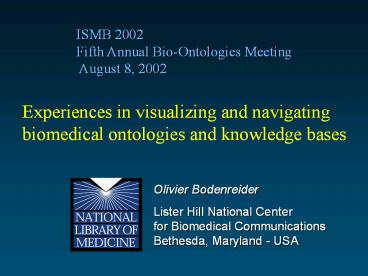Experiences in visualizing and navigating - PowerPoint PPT Presentation
Title:
Experiences in visualizing and navigating
Description:
Entry point: GO term or gene product name/symbol ... Left Phrenic. Nerve. Heart. Valves. Fetal. Heart. Medias- tinum. Saccular. Viscus. Angina. Pectoris ... – PowerPoint PPT presentation
Number of Views:46
Avg rating:3.0/5.0
Title: Experiences in visualizing and navigating
1
ISMB 2002 Fifth Annual Bio-Ontologies Meeting
August 8, 2002
Experiences in visualizing and navigating biomedic
al ontologies and knowledge bases
2
Introduction 1
- Biomedical knowledge
- Terminologies (names)
- Ontologies (objects)
- Knowledge bases (facts)
- Common features
- Terms / Concepts
- Inter-concept relationships
- Hierarchical
- Associative
3
Introduction 2
- Challenges
- Volume of information
- 104 - 106 concepts
- 105 - 107 relationships
- Orientation
- Mapping to concepts
- Visualizing concept spaces
- Navigating concept spaces
4
Introduction 3
- SemNav
- UMLS browser
- Entry point biomedical term
- Display related concepts
- Display properties of interconcept relationships
- Allow navigation among concepts
- GenNav
- GO browser
- Entry point GO term or gene product name/symbol
- Display related GO terms and gene products
- Display properties of term/term and term/gene
product relationships - Allow navigation between GO terms and gene
products
5
Outline
- Background
- Unified Medical Language System (UMLS)
- Gene Ontology
- Overview of the browsers
- SemNav
- GenNav
- Common features
- Differences
6
UMLS and GO
7
Unified Medical Language System
- Developed at NLM since 1990
- 13th edition in 2002
- Integrates some 60 terminological resources
- Clinical vocabularies (including specialties)
- Core terminologies (anatomy, drugs, med. devices)
- Administrative terminologies, standards
- Integration
- Synonymous terms are clustered in a concept
- Hierarchies (trees) are combined in a graph
structure
8
Terminology integration Terms
9
Terminology integration Relationships
10
UMLS
- Two-level structure
- Semantic Network
- 134 Semantic Types (STs)
- 54 types of relationshipsamong STs
- Metathesaurus
- 800,000 concepts
- 10 M inter-conceptrelationships
- Link categorization
11
(No Transcript)
12
Gene Ontology
- Developed by the GO Consortium
- Several components
- Ontology (11,000 concepts)
- Molecular functions
- Cellular components
- Biological processes
- Gene products (125,000)
- Associations between Gene products and GO
concepts (357,000)
13
SemNav
14
(No Transcript)
15
(No Transcript)
16
MeSH Browser
17
(No Transcript)
18
SemNav Visualization options
19
(No Transcript)
20
(No Transcript)
21
(No Transcript)
22
(No Transcript)
23
SemNav Relationships
24
GenNav
25
(No Transcript)
26
Material and Methods
27
(No Transcript)
28
(No Transcript)
29
(No Transcript)
30
Common features and differences
31
Mapping query terms
- Mapping terms to concepts
- Matching criteria (exact, approximate)
- Normalization techniques
- work well on clinical terms
- less applicable to gene names
- Query disambiguation
- With semantic type in SemNav
- With species in GenNav
32
Visualization
- Graph vs. Trees (Forest)
- Multiple inheritance is better visualized by
graphs than by trees - Off-the-shelf, freely available graph
visualization packages are available (GraphViz) - Need to reduce complexity
- Transitive reduction on complex graphs
- Feature selection
- e.g., a given vocabulary in SemNav
- e.g., a given species in GenNav
33
Navigation
- Tool for exploration
- Navigation among concepts(SemNav and GenNav)
- Navigation between two poles(Gene products and
GO concepts in GenNav) - Self-contained (SemNav)or opened to external
resources (GenNav)
34
Conclusions
35
Conclusions
- Most of the lessons learned while developing
SemNav (for browsing general biomedical
knowledge) were applicable to GenNav (for
browsing molecular biology knowledge) - The lexical techniques suitable for mapping text
to clinical terminologies require adaptation to
the specificity of molecular biology terminologies
36
Contact olivier_at_nlm.nih.gov
SemNav http//umlsks.nlm.nih.gov ? Resources ?
Semantic Navigator ( free UMLS registration
required) GenNav http//etbsun2.nlm.nih.gov8000
/perl/gennav.pl































